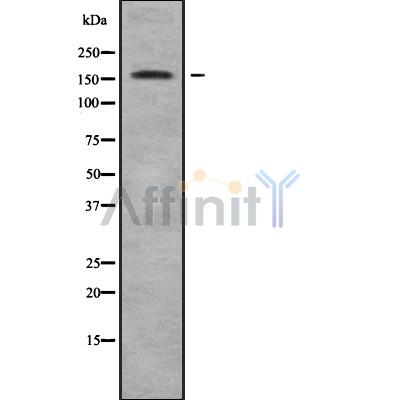ADAMTS13 Antibody - #DF9171
| Product: | ADAMTS13 Antibody |
| Catalog: | DF9171 |
| Description: | Rabbit polyclonal antibody to ADAMTS13 |
| Application: | WB IHC IF/ICC |
| Reactivity: | Human |
| Mol.Wt.: | 154kDa; 154kD(Calculated). |
| Uniprot: | Q76LX8 |
| RRID: | AB_2842367 |
Related Downloads
Protocols
Product Info
*The optimal dilutions should be determined by the end user.
*Tips:
WB: For western blot detection of denatured protein samples. IHC: For immunohistochemical detection of paraffin sections (IHC-p) or frozen sections (IHC-f) of tissue samples. IF/ICC: For immunofluorescence detection of cell samples. ELISA(peptide): For ELISA detection of antigenic peptide.
Cite Format: Affinity Biosciences Cat# DF9171, RRID:AB_2842367.
Fold/Unfold
A disintegrin and metalloproteinase with thrombospondin motifs 13; A disintegrin like and metalloprotease (reprolysin type) with thrombospondin type 1 motif 13; A disintegrin like and metalloprotease with thrombospondin type 1 motif 13; ADAM metallopeptidase with thrombospondin type 1 motif 13; ADAM TS; ADAM-TS 13; ADAM-TS13; ADAMTS 13; ADAMTS-13; ADAMTS13; ADAMTS13 protein; ATS13_HUMAN; C9orf8; TTP; Von Willebrand factor cleaving protease; von Willebrand factor-cleaving protease; vWF cleaving protease; vWF CP; vWF-cleaving protease; vWF-CP; vWFCP;
Immunogens
A synthesized peptide derived from human ADAMTS13, corresponding to a region within C-terminal amino acids.
- Q76LX8 ATS13_HUMAN:
- Protein BLAST With
- NCBI/
- ExPASy/
- Uniprot
MHQRHPRARCPPLCVAGILACGFLLGCWGPSHFQQSCLQALEPQAVSSYLSPGAPLKGRPPSPGFQRQRQRQRRAAGGILHLELLVAVGPDVFQAHQEDTERYVLTNLNIGAELLRDPSLGAQFRVHLVKMVILTEPEGAPNITANLTSSLLSVCGWSQTINPEDDTDPGHADLVLYITRFDLELPDGNRQVRGVTQLGGACSPTWSCLITEDTGFDLGVTIAHEIGHSFGLEHDGAPGSGCGPSGHVMASDGAAPRAGLAWSPCSRRQLLSLLSAGRARCVWDPPRPQPGSAGHPPDAQPGLYYSANEQCRVAFGPKAVACTFAREHLDMCQALSCHTDPLDQSSCSRLLVPLLDGTECGVEKWCSKGRCRSLVELTPIAAVHGRWSSWGPRSPCSRSCGGGVVTRRRQCNNPRPAFGGRACVGADLQAEMCNTQACEKTQLEFMSQQCARTDGQPLRSSPGGASFYHWGAAVPHSQGDALCRHMCRAIGESFIMKRGDSFLDGTRCMPSGPREDGTLSLCVSGSCRTFGCDGRMDSQQVWDRCQVCGGDNSTCSPRKGSFTAGRAREYVTFLTVTPNLTSVYIANHRPLFTHLAVRIGGRYVVAGKMSISPNTTYPSLLEDGRVEYRVALTEDRLPRLEEIRIWGPLQEDADIQVYRRYGEEYGNLTRPDITFTYFQPKPRQAWVWAAVRGPCSVSCGAGLRWVNYSCLDQARKELVETVQCQGSQQPPAWPEACVLEPCPPYWAVGDFGPCSASCGGGLRERPVRCVEAQGSLLKTLPPARCRAGAQQPAVALETCNPQPCPARWEVSEPSSCTSAGGAGLALENETCVPGADGLEAPVTEGPGSVDEKLPAPEPCVGMSCPPGWGHLDATSAGEKAPSPWGSIRTGAQAAHVWTPAAGSCSVSCGRGLMELRFLCMDSALRVPVQEELCGLASKPGSRREVCQAVPCPARWQYKLAACSVSCGRGVVRRILYCARAHGEDDGEEILLDTQCQGLPRPEPQEACSLEPCPPRWKVMSLGPCSASCGLGTARRSVACVQLDQGQDVEVDEAACAALVRPEASVPCLIADCTYRWHVGTWMECSVSCGDGIQRRRDTCLGPQAQAPVPADFCQHLPKPVTVRGCWAGPCVGQGTPSLVPHEEAAAPGRTTATPAGASLEWSQARGLLFSPAPQPRRLLPGPQENSVQSSACGRQHLEPTGTIDMRGPGQADCAVAIGRPLGEVVTLRVLESSLNCSAGDMLLLWGRLTWRKMCRKLLDMTFSSKTNTLVVRQRCGRPGGGVLLRYGSQLAPETFYRECDMQLFGPWGEIVSPSLSPATSNAGGCRLFINVAPHARIAIHALATNMGAGTEGANASYILIRDTHSLRTTAFHGQQVLYWESESSQAEMEFSEGFLKAQASLRGQYWTLQSWVPEMQDPQSWKGKEGT
Research Backgrounds
Cleaves the vWF multimers in plasma into smaller forms thereby controlling vWF-mediated platelet thrombus formation.
Glycosylated. O-fucosylated by POFUT2 on a serine or a threonine residue found within the consensus sequence C1-X(2)-(S/T)-C2-G of the TSP type-1 repeat domains where C1 and C2 are the first and second cysteine residue of the repeat, respectively. Fucosylated repeats can then be further glycosylated by the addition of a beta-1,3-glucose residue by the glucosyltransferase, B3GALTL. Fucosylation mediates the efficient secretion of ADAMTS13. May also be C-glycosylated on tryptophan residues within the consensus sequence W-X-X-W of the TPRs, and also N-glycosylated. These other glycosylations can also facilitate secretion.
The precursor is processed by a furin endopeptidase which cleaves off the pro-domain.
Secreted.
Note: Secretion enhanced by O-fucosylation of TSP type-1 repeats.
Plasma. Expressed primarily in liver.
The pro-domain is not required for folding or secretion and does not perform the common function of maintening enzyme latency.
The globular cysteineless spacer domain adopts a jelly-roll topology, and is necessary to recognize and cleave vWF. The C-terminal TSP type-1 and CUB domains may modulate this interaction.
References
Restrictive clause
Affinity Biosciences tests all products strictly. Citations are provided as a resource for additional applications that have not been validated by Affinity Biosciences. Please choose the appropriate format for each application and consult Materials and Methods sections for additional details about the use of any product in these publications.
For Research Use Only.
Not for use in diagnostic or therapeutic procedures. Not for resale. Not for distribution without written consent. Affinity Biosciences will not be held responsible for patent infringement or other violations that may occur with the use of our products. Affinity Biosciences, Affinity Biosciences Logo and all other trademarks are the property of Affinity Biosciences LTD.

